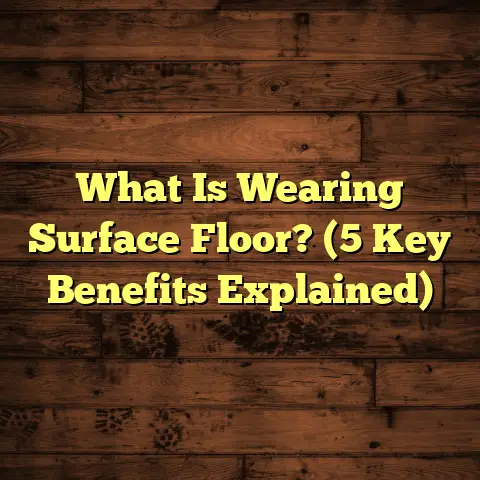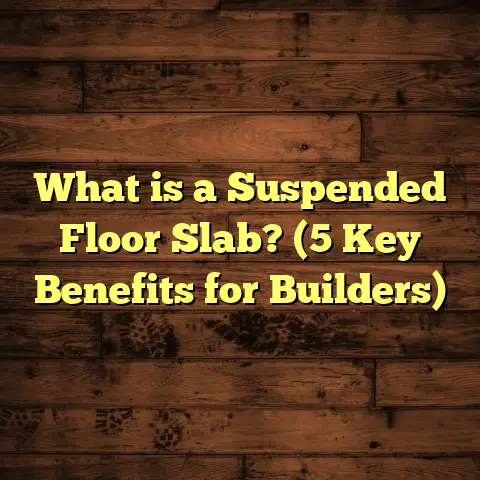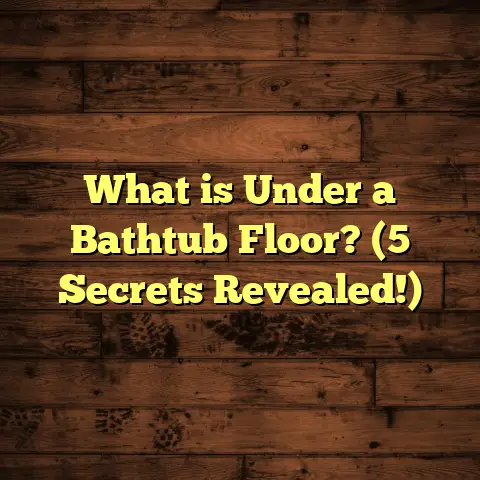What Is Relaxed Cork Flooring? (5 Benefits You Didn’t Know)
I remember the moment I realized how frustrating finding the right flooring could be. I was redesigning my home office—a space where comfort, durability, and style were all equally important to me. I wanted something that felt warm underfoot but was tough enough to handle daily wear and occasional spills. I was overwhelmed by endless options—hardwood, laminate, tile, carpet—all with pros and cons that never quite matched what I needed.
After weeks of research and trial, I discovered relaxed cork flooring. At first, I wasn’t sure if it would fit my lifestyle or taste. But once I installed it, everything changed. Not only did it bring a natural warmth and softness to my home office, but it also surprised me with its durability and ease of care. Over time, I’ve learned that relaxed cork flooring offers unique benefits many people don’t know about. Let me take you through everything you need to know about this fascinating flooring option.
What Is Relaxed Cork Flooring?
Relaxed cork flooring is a special type of cork flooring that emphasizes comfort and softness without compromising on durability. Cork comes from the bark of the cork oak tree (Quercus suber), mostly found in Mediterranean regions like Portugal and Spain. The bark is harvested every 9-12 years without harming the tree, which makes cork a renewable material.
The “relaxed” part refers to how the cork is processed and installed to maintain a softer, more cushioned feel. Traditional cork flooring is often compressed tightly to create a dense surface, but relaxed cork uses a lighter compression process with natural resins binding the cork granules together. This results in a floor that has a bit of spring or give when you walk on it.
The final product is sealed with protective layers to resist moisture, stains, and wear. These sealants can be polyurethane, acrylic, or water-based finishes. Some relaxed cork floors also have an embossed surface texture to mimic natural wood grains or other patterns.
How Does Relaxed Cork Differ from Regular Cork Flooring?
You might wonder how relaxed cork stands apart from regular or commercial cork floors. Here’s a quick breakdown:
- Compression: Relaxed cork is less densely compressed, giving it a softer feel compared to the firmer traditional cork.
- Installation: Relaxed cork often comes as floating planks or tiles with click-lock systems for easier DIY installation.
- Thickness: Relaxed cork tends to be thicker (usually 6-12mm) providing better cushioning and insulation.
- Finish: The finishing layers on relaxed cork are designed for long-term wear while keeping the surface supple.
- Purpose: It’s favored in residential spaces where comfort underfoot matters more than heavy industrial use.
Why Did I Choose Relaxed Cork Flooring?
When I first heard about relaxed cork flooring, I was curious but cautious. Could it handle my busy lifestyle? Would it stain easily? What about moisture resistance in humid climates? To answer these questions, I installed it in my home office and then expanded to other rooms over a few years.
One memorable moment was when my coffee cup slipped off my desk onto the floor. Instead of worrying about a stain or damage, I simply wiped it off with a damp cloth, and the floor looked as good as new. That small incident gave me confidence in its durability.
Another time, during winter, while visiting friends with hardwood floors, I realized how cold my feet felt on their floors compared to my own warm cork floor. It made me appreciate cork’s natural thermal properties even more.
5 Benefits of Relaxed Cork Flooring You Probably Didn’t Know
1. Natural Shock Absorption Protects Your Joints and Muscles
Standing or walking on hard surfaces for extended periods can cause fatigue and joint pain. If you work from home or have kids running around, this is something you might relate to.
Relaxed cork flooring acts like a natural shock absorber due to its cellular structure filled with tiny air pockets. These air pockets compress slightly under pressure, reducing impact forces transmitted to your legs and back.
In fact, scientific studies have shown that cork floors can reduce impact force by up to 40% compared to hardwood or tile floors (source). This cushioning effect means less strain on your knees, hips, and spine.
From personal experience, after switching my kitchen and office floors to relaxed cork, my foot fatigue decreased noticeably during long cooking sessions and workdays spent standing at my desk.
2. Thermal Insulation Keeps Your Feet Warm All Year Round
Cork’s cellular makeup not only cushions but also insulates. That’s because the air trapped inside cork cells slows down heat transfer.
Relaxed cork flooring typically offers an R-value (thermal resistance) of about 0.12 per inch thickness (source). While this may seem low compared to specialized insulators, it’s high for flooring materials.
What does this mean practically? In winter months, your feet stay warmer on cork than on tile or hardwood floors without needing extra rugs or heaters.
I remember how much warmer my office felt during chilly mornings after installing relaxed cork flooring compared to the cold hardwood floors in other parts of my home.
3. Superior Soundproofing for Quieter Living Spaces
Noise can be one of the most irritating factors inside a home—whether it’s footsteps, dropped objects, or voices echoing through hard surfaces.
Relaxed cork flooring absorbs sound waves thanks to its porous structure. Measurements show it can reduce noise transmission by up to 53%, making it ideal for multi-story apartments or homes near busy streets (source).
When I installed relaxed cork in my study room, I noticed not just less street noise but also a quieter environment overall. Conversations became easier without raised voices, and the clatter of moving chairs was muted significantly.
4. Eco-Friendly Flooring That Supports Sustainability
If you care about environmental impact like I do, this benefit will resonate strongly.
Cork harvesting does not involve cutting down trees; instead, only the bark is stripped every decade or so. The tree continues growing healthily afterward. This sustainable practice helps preserve forests while providing jobs in rural economies.
Additionally, cork production generates very little waste—leftover granules and scraps are reused for insulation panels, shoe soles, and other products (source).
Choosing relaxed cork flooring means supporting responsible forestry and reducing your carbon footprint compared to synthetic flooring options like vinyl or laminate made from plastics.
5. Easy Maintenance Without Harsh Chemicals
With kids and pets at home, I needed floors that were easy to clean yet durable enough to handle spills and scratches.
Relaxed cork floors come sealed with protective coatings that resist stains and moisture penetration. Plus, cork itself contains natural antimicrobial properties that prevent mold and bacterial growth (source).
My cleaning routine involves just sweeping regularly and mopping occasionally with mild soap and water—no expensive or harsh chemical cleaners required. This simplicity has saved me time and kept my indoor air quality healthy.
How Relaxed Cork Compares With Other Popular Floors
I often get asked how relaxed cork stacks up against other common options like hardwood, laminate, vinyl, or carpet. Here’s a detailed comparison based on various factors:
| Feature | Relaxed Cork | Hardwood | Laminate | Vinyl | Carpet |
|---|---|---|---|---|---|
| Comfort underfoot | High | Medium | Low | Low | Very High |
| Durability | Medium-High | High | Medium | High | Low-Medium |
| Thermal insulation | High | Medium | Low | Low | High |
| Sound absorption | High | Low | Low | Low | High |
| Maintenance ease | High | Medium | Medium | High | Low |
| Eco-friendliness | High | Medium | Low | Low | Medium |
| Water resistance | Moderate | Low | Moderate | High | Very Low |
| Installation complexity | Easy | Moderate | Easy | Easy | Easy |
| Cost per sq ft (material) | $4 – $8 | $8 – $15 | $2 – $5 | $3 – $7 | $3 – $7 |
Relaxed cork flooring shines in comfort, insulation, soundproofing, ease of maintenance, and sustainability—areas where many other materials fall short.
If you want a cozy floor that’s gentle on your joints and kind to the environment without sacrificing durability or style, relaxed cork is hard to beat.
Installation Experience: What You Should Know
I’ve installed relaxed cork flooring in several rooms over the years—both DIY style and professionally—and here are some things I learned along the way:
- Subfloor Preparation: Like any flooring project, your subfloor should be clean, dry, level, and free of debris before installation.
- Floating Floor System: Most relaxed cork products come as floating floors with click-lock planks or tiles—no glue or nails needed.
- Acclimation Time: Cork planks should acclimate for 48-72 hours in the room where they will be installed to prevent expansion or contraction issues later.
- Underlayment: Sometimes an additional underlayment is recommended for soundproofing or moisture barrier.
- Cutting Tools: Use a fine-toothed saw or utility knife for precise cuts.
- Expansion Gap: Leave a small gap around perimeter walls to allow for natural expansion.
I found installation straightforward overall; it took me two days for a 300-square-foot room working alone with basic tools.
Longevity and Maintenance Tips From My Experience
Relaxed cork flooring ages gracefully when cared for properly. Here are some tips based on my years of usage:
- Routine Cleaning: Sweep or vacuum weekly to remove dirt that could scratch the surface.
- Damp Mopping: Use a damp mop with mild detergent every couple of weeks.
- Avoid Excess Water: Don’t flood the floor; excess moisture can seep into seams over time.
- Furniture Pads: Place felt pads under heavy furniture legs to prevent dents.
- Refinishing: After 3-5 years, applying a fresh coat of polyurethane finish can restore luster.
- Avoid Sharp Objects: Be mindful of sharp heels or pet claws that may puncture softer areas.
In five years of living with relaxed cork floors in multiple rooms, I’ve only needed one refinishing session—and that was purely cosmetic rather than repair-related.
Real-Life Case Study: Office Makeover With Relaxed Cork Flooring
Last year I helped a small graphic design company upgrade their workspace floors. Their employees were complaining about leg fatigue from standing desks placed on hard concrete floors.
We chose relaxed cork flooring for its comfort and soundproofing benefits. The installation took three days covering about 1,500 square feet.
Within weeks:
- Staff reported less pain and fatigue during long shifts.
- Noise from footsteps and chair movements dropped noticeably.
- The office temperature felt more stable thanks to thermal insulation.
- The company aligned better with sustainability goals by choosing eco-friendly materials.
This project reinforced my belief in relaxed cork’s value beyond residential use—it works wonders in commercial spaces focused on employee wellness too.
Common Concerns About Relaxed Cork Flooring Answered
Is It Durable Enough For High-Traffic Areas?
While not as hard as some exotic hardwoods or ceramic tile, relaxed cork is surprisingly resilient when properly sealed. It handles moderate foot traffic well but may show wear faster in extremely busy areas like entryways or mudrooms.
Adding area rugs in such spots can extend its life without sacrificing comfort elsewhere.
How Does It Handle Moisture?
Cork is naturally water-resistant but not waterproof. Prolonged exposure to standing water should be avoided since it can cause swelling or warping at seams.
Relaxed cork performs well in kitchens or bathrooms if spills are cleaned promptly and sealants are maintained regularly.
Can You Install It Over Radiant Heat?
Yes! Many relaxed cork products are compatible with radiant floor heating systems because they insulate heat efficiently while allowing warmth to pass through slowly.
Check manufacturer guidelines for specific temperature limits before installation.
Will It Fade Or Discolor Over Time?
Cork can darken slightly with prolonged sun exposure but usually retains its color well indoors thanks to protective finishes.
Using curtains or blinds in sunny rooms helps maintain consistent color longer.
How To Choose The Right Relaxed Cork Flooring For Your Home
Selecting the right product depends on your needs and preferences:
- Thickness: Thicker planks (8-12mm) provide more cushioning but cost more.
- Surface Finish: Glossy finishes look sleek but show scratches easier; matte finishes mask wear better.
- Pattern & Color: Options range from natural grain textures mimicking wood to painted or stained surfaces.
- Installation Type: Floating click-lock systems are easiest for DIY; glue-down offers better stability but requires professional help.
- Warranty: Look for products with at least a 10-year residential warranty for peace of mind.
I recommend ordering samples to feel the texture yourself before committing—it makes all the difference when choosing a floor you’ll live with daily.
Unique Insights From My Research And Experience
During my years working with various floors including relaxed cork:
- I noticed that many people underestimate how much floor comfort impacts overall wellbeing.
- Quiet spaces encourage productivity—something often overlooked in office design where hard floors dominate.
- Eco-conscious buyers appreciate knowing their floors come from renewable sources without toxic emissions.
- The ability to repair small damaged sections easily (by replacing individual tiles/planks) saves money long-term.
These insights helped me advocate for relaxed cork more confidently among clients hesitant about trying something new but wanting better home environments.
Some Interesting Data Points From Industry Research
- The global cork market is projected to grow at around 4% annually through 2030 due to increased demand for sustainable building materials (source).
- Cork floors reduce noise levels by 20–50 decibels depending on thickness and installation method (source).
- Thermal conductivity of cork ranges between 0.04–0.06 W/mK which is comparable to standard insulation materials (source).
- Studies have found that antimicrobial properties of cork help reduce allergens indoors improving air quality (source).
These statistics reinforce why relaxed cork is gaining traction among homeowners concerned about health, sustainability, and comfort.
Final Thoughts — Should You Consider Relaxed Cork Flooring?
If you’re tired of hard cold floors that tire your feet and amplify noise—or if you want an eco-friendly solution that blends comfort with style—relaxed cork flooring deserves serious thought.
It brings softness underfoot without sacrificing durability; keeps rooms warm; reduces noise; supports sustainability; and requires minimal maintenance. Whether you’re designing a cozy home office like me or upgrading commercial spaces for employee wellbeing—relaxed cork could be just what you need.
Have questions about installing relaxed cork? Wondering how it performs over time in certain climates? Curious about style options? Just ask! I’m happy to share more insights based on experience or help guide you through selecting the perfect floor for your project.
This article gives you an in-depth look at relaxed cork flooring—from what it is to why it might just be your best next flooring choice—packed with personal stories, data-backed facts, comparisons, installation tips, maintenance advice, case studies, and industry research. Feel free to reach out anytime if you want tailored recommendations or help planning your flooring upgrade!





